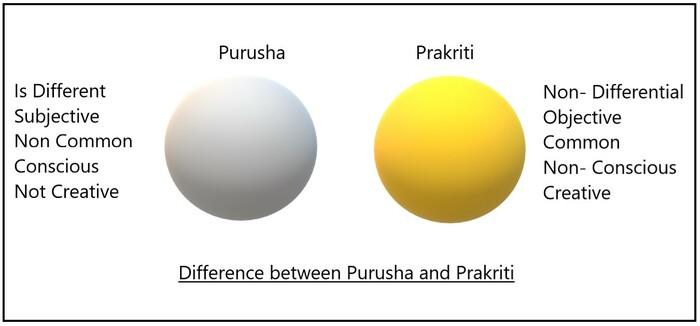Author: Randeep Singh / go to all Samkhya Karikas

Samkhya Karika 11 text:
Trigunam aviveki vishyah saamaanyam achetanam prasavadharmi ||
Vyaktam tathaa pradhaanam tadvipareetas tathaa cha pumaan ||
Trigunam – made of three gunas
Aviveki – indistinguishable, non-differentiated
Visayah – the object of, objective
Saamaanyam – common, general
Achetanam – non-conscious, non-intelligent
Prasavadharmi – productive, can creat
Vyaktam – the manifested
Tathaa – therefore
Pradhanaam – first cause of everything
Tadvipareetas – the opposite of that
Tathaa Cha – and so also
Pumaan – soul, the conscious spirit
After establishing the difference between Mula Prakriti (unmanifested) and Prakriti as it manifests itself as the various elements of the universe in the previous Karika Isvar Krishna in this Samkhya karika 11explains the difference between these two forms of Prakriti and Purusha.
How is Prakriti Different from Purusha?
The main ingredient of which Prakriti – both unmanifest and manifest forms – is made up of are the three gunas – Sattva, Rajas, and Tamas. The three gunas will be further elaborated upon in the next two karikas. Much before the process of evolution begins the three gunas are present in the Mula Prakriti (unmanifest) as homogeneously mixed undifferentiated form of matter. These gunas are in a state of equilibrium here, for evolution to begin this equilibrium needs to be disturbed – to manifest its effect – by some cause.
The homogenous existence of these gunas isn’t a static state, but a dynamic state in which each guna present there in is mutating only within itself, thus not producing – manifesting – anything different that itself. The process of evolution begins only when Purusha and Prakriti come close to each other – due to some cause inherent in Mula Prakriti itself– and an endless heterogenous mixing of gunas takes place which creates, produces various states of matter.
Thus the entire material world has both its source and cause in the Mula Prakriti. This karika elaborates upon the nature and characteristics of Prakriti, as it begins to manifest as material elements in order to highlight its contrast with Purusha. The manifestation of Mula Prakriti as matter is distinct as it is:
Aviveki – Non – differentiated: This means that the manifested state, or evolutes of Prakriti have the same nature, construct, and essence as its cause or the Mula Prakriti as the parent body from which they evolve. Mahat, or Budhi the first manifested form of Mula Prakriti is seemingly as subtle as the Mula Prakriti, or Purusha (consciousness) in its construct that it is difficult to tell them apart.
We often use terms like “ I think”, and “ I am” where we because of their non-differentiated nature due to similarities in their essence join “ think” which is the intellect (Budhi) with “I” which is Ahamkara ( Ego), where as both of these manifested forms of Prakriti are very different from each other. Similarly constructively different entities “ I” ( Ahamkara) is mistakenly joined with “am” ( Consciousness or Purusha) in our conversations.
Buddhi, though the evolute of Prakriti can reflect Purusha in it due to its subtleness and nearness to Purusha. Thus, Purusha and Prakriti seem to be the same, appear non-differentiated as both are extremely subtle in their essence, but actually are two distinct entities.
Vishyah – Objective: The manifested world, Prakriti, is objective in nature, means the attributes of its existence can be objectified, measured, and rationale empirically. That is why Samkhya philosophy is called as realist. The manifested form of Prakriti (the world) can be known through the senses, which is not the case with Purusha (Consciousness).
Saamaanyam – Common: The manifested forms of Prakrit are same and common for all. A tree will be a tree for anyone who perceives it through its senses, a tree cannot be a tree for some and something else for others. This is because the evolutes of Prakriti are objective in nature, not a subjective concept.
Achetanam – Non-Conscious: The manifested form of prakriti is purely matter, and thus lacks consciousness. On the other hand, Purusha is absolute consciousness.
Prasavadharmi – productive, generative, can create other evolutes from themselves: Though the manifested forms of Prakriti lack consciousness they can reproduce other entities, prakriti in its manifested for can generate and produce that is why it is said that Prakriti evolves. This potential of constant development (transformation) is unique to only Prakriti, Purusha lacks this capacity.
Samkhya karika 11 introduces the conscious principle “puman”( as substitute to Purusha) which is entirely opposite of Prakriti in nature and characteristics. Purusha is distinctive, subjective, not common for all, conscious, and is non generative in nature. Later we will know that even this conscious principle is real and eternal but different from Prakriti. As Samkhya is based on these two distinct entities – Purusha and Prakriti – it is known as a realistic and dualistic philosophy.
One needs to learn that one should identify one with something that is non-changing (Purusha) and not something that is transitory (Prakriti). On the contrary all our lives are spent chasing material things (Prakriti) like houses, cars, status, and identity.
Suffering comes from getting attached to things which are not real. No-permanency of material world causes pain. Samkhya Philosophy teaches us to identify ourselves with something that is real and eternal.
